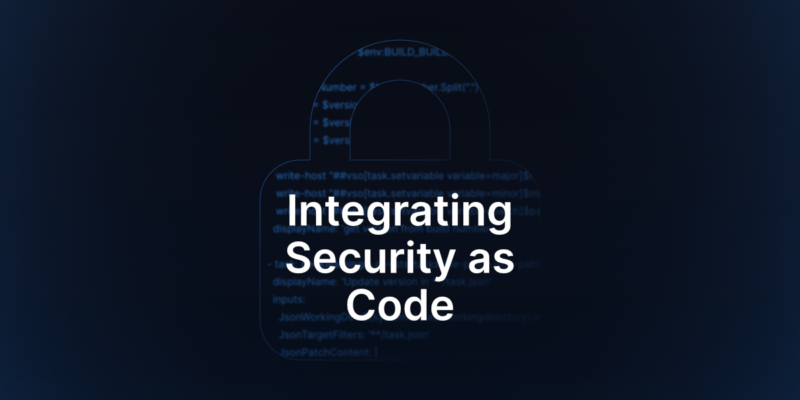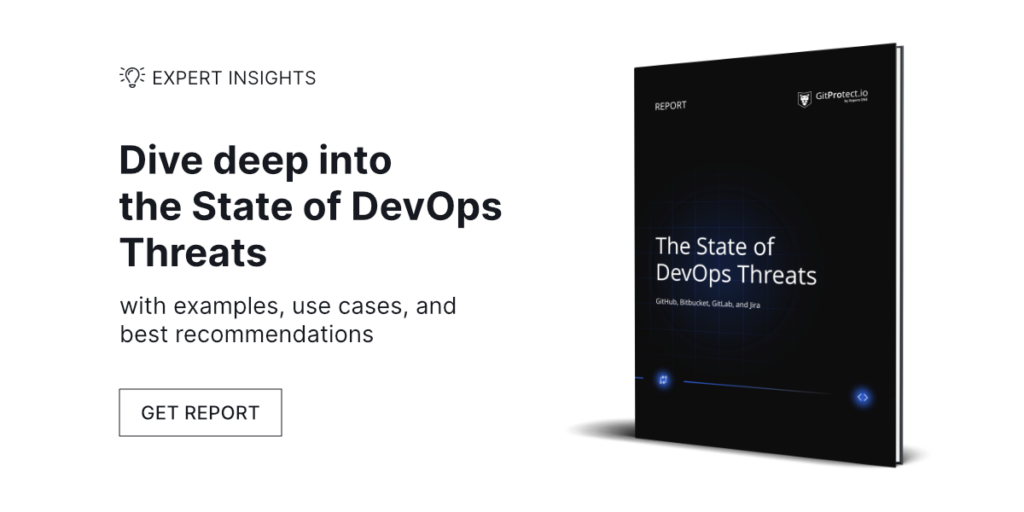
Integrating Security as Code: A Necessity for DevSecOps
Security practices in DevOps have evolved from being a minor concern to one of the main focus points, which resulted in the DevSecOps movement. It’s about “shifting security to the left” in the software development lifecycle – so the security measures are a fundamental component.
Traditionally, security management was moved to the final stages of developing software, and it has proven its ineffectiveness in dealing with the challenges of modern software projects. This is where Security as Code (SaC) comes in. It is a way to integrate security into every phase of development, from start to deployment, so that security and development teams can work together effectively and successfully.
What is Security as Code?
By Security as Code, we mean that security checks, threat modeling, testing, and risk assessments are integrated into the Continuous Integration and Continuous Delivery (CI/CD) pipeline. This way we can have real-time security feedback, detect vulnerabilities early, and, most importantly, have the ability to address security concerns at the time they appear during development, rather than aftermath. There are two key things regarding Security as Code and DevSecOps that you need to keep in mind, though:
- automation
- and shifting security left.
🔎 Check out GitProtect.io’s ultimate study on the most severe security breaches and incidents, and top security best practices to eliminate them:
Why is SaC so important for DevOps?
As organizations adopt more agile and DevOps-centric approaches, traditional methods of implementing security measures after development have become increasingly ineffective and risky. SaC confronts these challenges by providing a range of benefits to meet the demands of modern, fast-paced software delivery cycles.
To shift left and implement successful DevSecOps practices, you need to adopt Security as Code. Why? Well, security measures and expectations should be clearly defined at the very start of a project; then, if you want them to be consistently used, they should be codified. In turn, this will lead to more secure coding as your developers will be able to self-check their code. Therefore, your projects will be more secure due to automated processes still being checked, which will improve overall efficiency.
Top benefits of security as Code
Now that we have discussed the meaning and importance of Security as Code, we can take a look at the benefits it can bring. They range from better communication across teams to quicker detection and fixes of appearing bugs or issues. However, the main and core aspect that SaC brings to the table is better overall security of your organization. So, let’s have a closer look at the SaC top benefits:
- The possibility to detect threats before production and, as a consequence, the opportunity to minimize potential security vulnerabilities.
- It permits operations development, and security teams to work effectively (let’s not forget you get DevSecOps this way!).
- Thanks to the automation of security measures, you can reduce the occurrence of potential human errors.
- You can meet compliance, industry, regional, and security requirements.
- The possibility to shorten release cycles, as you have security check automation.
- It allows you to get consistent and reliable security configurations within your deployments and environments.
Key components of Security as Code
SaC has three main aspects it revolves around – access control and policy management, security testing, and vulnerability scanning.
When it comes to access controls, it is important to carefully manage and monitor the granted access. Make sure that users only have the necessary access to complete their tasks. Consider Role-Based Access Controls (RBAC) and the least privilege principle to securely approach access control processes. Customizing permissions according to roles allows you to simply assign an individual to their role and they will receive the access controls granted for that role. Then, specifying permissions for individual users, although time-consuming, allows you to tailor access controls to the minimum requirements of each employee. Set up your policies and manage them in terms of how access is revoked, denied, and granted. That should allow for easier tracking of the given permissions and promote accountability.
As for security testing, it is important that the process of detecting and mitigating vulnerabilities in code is codified. This will improve the availability, integrity and confidentiality of your application. Security testing, helps to stay compliant with industry regulations such as SOC 2, and makes it easier to spot:
- potential malfunctions
- sensitive data exposure
- misconfigurations
Vulnerability testing helps to find weak spots in your application or infrastructure that can be exploited by threat actors. OWASP is a great resource to stay up-to-date with cyber security risks surrounding DevOps. Now, you should leverage vulnerability scans to quickly address any identified weaknesses and stay one step ahead of any attacks or disaster scenarios!
Best practices to implement SaC
Below we will outline practical steps to implement security as code to adopt the shift left approach and keep your code protected. Moreover, it’s worth combining the shift left strategy and automation… and voila, you get your DevSecOps.
Continuous security
The first question is how can you improve the efficiency along with security across your organization? Well, it’s worth starting with automation – try to automate more complicated time and resource-consuming tests, such as penetration testing. Once automated, they can be used by you or your team across multiple settings and projects, which will lead to better detection of any potential security risks, and will allow you to deal with them much quicker too.
Your teams should automate security scans across different environments and projects by adding them to their CI/CD pipeline. The SAST (Static Application Security Testing) and DAST (Dynamic Application Security Testing) tools can be automated to search for vulnerabilities in both the codebase and the running apps, which will result in fast feedback and early fixes, therefore it protects the software against any exploitation.
Shift security left and promote secure code practices
Remember that at the start of any project, your first step should be to find out what your expectations are. Moreover, you should define the security measures you will need.
Next, provide your development teams with all the information and tools they need. It will help create secure code from the very beginning. For example, you can implement a testing or staging environment to carry out tests, rather than just doing the tests in production environments. This might lead to better vulnerability management and can help you decrease potential security risks early in the development cycle.
Continuous monitoring and feedback
Next, let’s go into continuous monitoring and feedback. One of the main advantages of real-time monitoring is that it helps you keep track of the security of your software or infrastructure in real-time. Make sure to have automated mechanisms in place to notify you as soon as possible if any threat does get detected; and also alert relevant teams about potential security risks. This way if there is an error with a part of code or someone is trying to break through your access controls, you will be aware instantly and move on to dealing with the issue at hand.
Moreover, you should create a continuous feedback loop to search for information regarding security issues and any new arising threats, which could potentially affect your project. Therefore, you will be able to use this knowledge to continuously improve your security measures by integrating what you learned into your security policies as time goes on.
Implement least-privilege access
Another key thing is to set up RBAC (Role-Based Access Control). These permissions should be assigned based on job roles and responsibilities. Make use of access limitations that narrow down the access abilities of users to only the activities and resources, which are necessary to complete tasks. By doing so, you reduce the risk of unauthorized access. In addition, you should take care of audits and evaluations of access controls if you want to guarantee that they comply with the principles of least privilege. Take advantage of things like automated scanning tools to find and fix any misconfigurations or excessive permissions throughout your ecosystem.
Educate your team
Make sure that each member of your team understands the security procedures and follows a security-oriented environment. Therefore, you could host training sessions to allow your personnel to learn about the significance of least-privilege access and the best tips to put it into practice. Encourage your development teams and administrators to follow least privilege principles in their everyday tasks to decrease the risk of unauthorized access.
Additionally, you should train your development team in regard to secure coding methods, the importance of clear communication and feedback, as well as awareness of common vulnerabilities.
Backup
To elevate your security even further, make sure that you have backup and Disaster Recovery policies. Regular backups of source code and metadata are crucial if you want to ensure workflow continuity in any event of failure.
Thus, your backup and DR software should allow you to set up automated scheduled backup policies, cover all your repositories and metadata (of GitHub, GitLab, Bitbucket, Azure DevOps), ensure ransomware protection, and provide restore and DR features meeting any disaster scenario.
How does GitProtect.io help with the security of your source code?
Backup is a final line of protection, therefore it is important to take it seriously. Make sure that all your DevOps stack is backed up, whether you use GitHub, GitLab, Bitbucket, Azure DevOps, or Jira. For example, with GitProtect.io you can easily back up both repositories, metadata, and project data (when it comes to Jira).
GitProtect.io backup and DR software allows you to build your backup within the backup best practices, including automated scheduled backups, full data coverage, the possibility of choosing your deployment model (cloud, on-pemise), multi-storage compatibility to meet the 3-2-1 backup rule, unlimited retention, replication between storage destinations, AES encryption with your own encryption key, ransomware protection, restore and Disaster Recovery Technology. All those features can help organizations to ensure that in any event of a disaster, they will be able to eliminate data loss and ensure business continuity of their software development life cycle.
“With GitProtect, we can be sure that our repos and metadata are being automatically backed up and can be easily restored in case Bitbucket or GitHub goes down.”
Sarah Reed, Software Engineer at Crow Insight
Read more Case Studies on how GitProtect.io helps organizations meet their data protection, code security, and compliance requirements.
[FREE TRIAL] Ensure compliant DevOps backup and recovery with a 14-day trial 🚀
[CUSTOM DEMO] Let’s talk about how backup & DR software for DevOps can help you mitigate the risks







